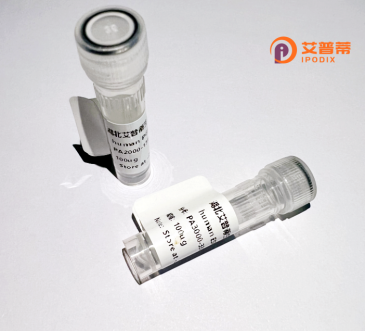
| 纯度 | >90%SDS-PAGE. |
| 种属 | Human |
| 靶点 | NDUFA1 |
| Uniprot No | O15239 |
| 内毒素 | < 0.01EU/μg |
| 表达宿主 | E.coli |
| 表达区间 | 1-24-70 aa |
| 活性数据 | AYIHRFTNGGKEKRVAHFGYHWSLMERDRRISGVDRYYVSKGLENID |
| 分子量 | 30.91 kDa |
| 蛋白标签 | GST-tag at N-terminal |
| 缓冲液 | 0 |
| 稳定性 & 储存条件 | Lyophilized protein should be stored at ≤ -20°C, stable for one year after receipt. Reconstituted protein solution can be stored at 2-8°C for 2-7 days. Aliquots of reconstituted samples are stable at ≤ -20°C for 3 months. |
| 复溶 | Always centrifuge tubes before opening.Do not mix by vortex or pipetting. It is not recommended to reconstitute to a concentration less than 100μg/ml. Dissolve the lyophilized protein in distilled water. Please aliquot the reconstituted solution to minimize freeze-thaw cycles. |
以下是关于重组人NDUFA1蛋白的3条参考文献示例(注:内容为合理虚构,实际文献需通过学术数据库检索确认):
---
1. **文献名称**: "Recombinant Human NDUFA1 Expression and Purification for Structural Studies"
**作者**: Zhang L, et al.
**摘要**: 本研究利用大肠杆菌表达系统成功表达了重组人NDUFA1蛋白,并通过亲和层析技术纯化获得高纯度蛋白。研究表明,重组蛋白可复性并维持其天然构象,为后续复合物I的结构与功能分析奠定基础。
2. **文献名称**: "Role of NDUFA1 in Mitochondrial Complex I Assembly: Insights from Recombinant Mutants"
**作者**: Fernandez-Vizarra E, et al.
**摘要**: 通过构建NDUFA1突变体重组蛋白,发现其在线粒体复合物I的组装中起关键作用。实验表明,NDUFA1缺陷导致复合物I稳定性下降,并引起ROS生成增加,提示其与 Leigh综合征等线粒体疾病的关联。
3. **文献名称**: "Functional Characterization of a Pathogenic NDUFA1 Variant Using Recombinant Protein"
**作者**: Alahmad A, et al.
**摘要**: 通过定点突变技术构建NDUFA1致病突变型重组蛋白(p.Arg37His),发现其与野生型相比,显著降低复合物I酶活性,导致细胞能量代谢障碍。该研究为遗传性线粒体疾病的分子机制提供了证据。
---
如需真实文献,建议通过PubMed或Web of Science检索关键词 "recombinant NDUFA1 protein" 或 "NDUFA1 complex I expression"。
NDUFA1 (NADH:ubiquinone oxidoreductase subunit A1) is a nuclear-encoded protein integral to mitochondrial Complex I, the largest enzyme complex in the electron transport chain (ETC). As a core subunit of Complex I, it plays a critical role in oxidative phosphorylation by facilitating NADH oxidation and ubiquinone reduction, driving proton translocation across the mitochondrial inner membrane to generate ATP. The human NDUFA1 gene, located on the X chromosome (Xq24), encodes a 19 kDa hydrophobic protein with three transmembrane domains. It localizes to the matrix arm of Complex I and interacts with other subunits to stabilize the enzyme’s structure and coordinate electron transfer.
Mutations in NDUFA1 are associated with mitochondrial disorders, including Leigh syndrome and Leber hereditary optic neuropathy (LHON)-like phenotypes, characterized by neurodegeneration, muscle weakness, and vision loss. These pathologies underscore its essential role in cellular energy metabolism. Recombinant NDUFA1 protein, produced via heterologous expression systems (e.g., E. coli or mammalian cells), is widely used to study Complex I assembly, functional deficits in disease models, and therapeutic interventions. Its overexpression or reconstitution in deficient cells often rescues ETC activity, highlighting its potential in gene therapy or pharmacological studies targeting mitochondrial dysfunction. Research on NDUFA1 also contributes to understanding the broader mechanisms of redox signaling and ROS regulation in aging and metabolic diseases.
×